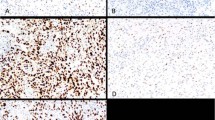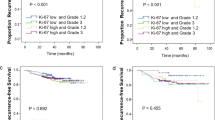Abstract
Prognostic information is essential for the evaluation, judgement and optimal treatment of patients with squamous cell cancers (SCCs) of the upper aerodigestive tract. Using immunohistochemical and flow cytometric techniques, we have studied the significance of cellular expression of the Ki-67 antigen, epidermal growth factor receptor (EGFR), the transferrin receptor (TFR) and DNA ploidy status in a prospective analysis of patients with SCCs of the head and neck region. All 42 fresh tumour samples (five well differentiated; 28 moderately differentiated; nine poorly differentiated) expressed both EGFR and TFR to varying degrees. Receptor expression was most marked on the peripheral invading margin of cancer cell islands although staining was also demonstrated in a random fashion within cellular islands and consistently along the basal cell layer of overlying stratified squamous epithelium. The percentage of cancer cells that reacted with the Ki-67 monoclonal antibody was assessed as low (less than 10%) in 15 samples (35.8%), intermediate (10-30%) in 19 samples (45.2%) and high (greater than 30%) in eight samples (19.0%). Eleven of 15 samples (73%) with a low percentage reactivity were DNA diploid, whereas seven of eight samples (87.5%) with a high percentage reactivity were DNA aneuploid. Poorly differentiated SCCs were significantly more often aneuploid than were either moderately or well differentiated tumours. Our results suggest that EGFR and TFR are widely distributed on SCCs, especially on proliferating cells at the invading tumour margin. In addition, there is a close spatial correlation between cells expressing EGFR, TFR and those expressing the Ki-67 antigen. Tumours in which the staining intensity for both EGFR and TFR was intense invariably expressed the Ki-67 antigen in a high proportion of cells. Further patient follow-up will be important in determining whether intense EGFR and TFR staining, combined with a high percentage reactivity with Ki-67 antibody and DNA aneuploidy, will ultimately define a subset of head and neck cancer patients with a poor clinical outcome.
This is a preview of subscription content, access via your institution
Access options
Subscribe to this journal
Receive 24 print issues and online access
$259.00 per year
only $10.79 per issue
Buy this article
- Purchase on Springer Link
- Instant access to full article PDF
Prices may be subject to local taxes which are calculated during checkout
Similar content being viewed by others
Author information
Authors and Affiliations
Rights and permissions
About this article
Cite this article
Kearsley, J., Furlong, K., Cooke, R. et al. An immunohistochemical assessment of cellular proliferation markers in head and neck squamous cell cancers. Br J Cancer 61, 821–827 (1990). https://doi.org/10.1038/bjc.1990.184
Issue Date:
DOI: https://doi.org/10.1038/bjc.1990.184
This article is cited by
-
Role of EGFR as prognostic factor in head and neck cancer patients treated with surgery and postoperative radiotherapy: proposal of a new approach behind the EGFR overexpression
Medical Oncology (2017)
-
The clinical relevance of Ki-67 expression in laryngeal squamous cell carcinoma
European Archives of Oto-Rhino-Laryngology (2015)
-
MAPKs activation in head and neck squamous cell carcinomas
Oncology Reviews (2011)
-
Non-invasive imaging of angiogenesis in head and neck squamous cell carcinoma
Angiogenesis (2010)



